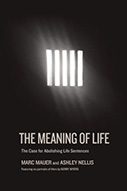The Meaning Of Life: The Case For Abolishing Life Sentences

Author: Marc Mauer and Ashley Nellis
Publisher: New York: The New Press, 2018. 204 p.
Reviewer: Sam Bieler | March 2019
After the federal First Step Act passed in 2018, a natural question for many in the reform community was “what comes next?” The Meaning of Life offers an answer: ending life sentences. Co-authored by Marc Mauer and Ashley Nellis, with supplemental material by Kerry Myers, The Meaning of Life is a ferociously persuasive case against the use of life sentences. Its arguments are well-organized and honed to a razor’s edge, and its policy proposals have a remarkable clarity and thoroughness. At the same time, it never loses sight of the human stakes of the argument and it works hard to persuade readers of its case.
This book is the tip of the spear in the Sentencing Project’s initiative to eliminate life sentences, and it takes up the cause with aggressive rigor and precision. The book alternates between chapters arguing against life sentences on empirical grounds, and chapters written by Myers that tell the story of particular lifers who have accomplished remarkable transformations in their lives or whose sentences seemed particularly egregious given their conduct.
The balance is an effective one thanks to the authors’ clear and efficient writing. Many of the arguments in The Meaning of Life against life sentences, such as their marginal contribution to public safety, will be familiar to those who have tracked the ongoing debate over justice reform. However, the authors have done an excellent job of honing these arguments down to the most essential elements and most impactful evidence. Thus, while no chapter extends over twenty-five pages, the arguments never feel rushed or truncated. The authors give readers exactly what they need to persuade, and not a word more. Each chapter also builds efficiently on the argument before it and leads naturally to the next. The authors dispose of the arguments in favor of life sentences with military efficiency, and then counterattack with their case for eliminating the practice.
Juxtaposed against these crisp empirical arguments, Myers’ stories could feel jarring or overly sentimental, but their positioning and framing make them a humanizing reference point. Myers does not shy away from the crimes of his subjects nor does he minimize them. He does, however, balance their crimes against their repentance in a way that underlines the brutality of a life sentence. Spacing these tales throughout the book provides human faces to the empirical arguments made by Mauer and Nellis, and offers a refreshing change of pace.
What sets The Meaning of Life apart from so many other books on the justice system is the clarity of its proposed reforms. All too often, books succeed at arguing that the status quo is bad and that something should be done. However, they stumble on what this something should be — lapsing into nebulous calls for reform. The Meaning of Life does not have that problem – the authors want a 20-year maximum sentence, retroactively applied to anyone currently in prison, with empirically driven reviews to identify rare cases where further confinement is necessary to prevent further harm. That the proposed solution can be summarized so efficiently is itself a testament to the care and precision Mauer and Nellis have put into developing their proposal.
Equally important, the proposal is framed in a way that addresses the arguments against it. For example, the authors propose allowing the extension of sentences in certain, limited cases where public safety would otherwise be endangered. A critic might note that this was the animating instinct behind indefinite sentences. Judges set out a minimum sentence to be served and then a parole board ends the sentence once they feel rehabilitation has been achieved. These boards, however, often politically-appointed, frequently find that such reformation is never attained and sentences stretch on year after year. Mauer and Nellis have considered this threat and propose a detailed and empirically driven review program designed to minimize this risk.
This rigor enhances the value of The Meaning of Life’s proposal in two ways. First, it is always rewarding for a reader who identifies issues with a proposal to see that the author has similarly considered those risks and proposed solutions. One sets this book down confident that serious thought has gone into both the benefits and flaws of a 20-year maximum. Second, it provides a ready supply of responses when advocates for the a 20-year maximum face-off with opponents. It is always helpful to have ready responses to counterarguments, and Mauer and Nellis work hard to ensure that their supporters’ quivers will be full.
This clarity and comprehensiveness falters only when considering the moral case against life sentences. The Meaning of Life seems to suggest there is a moral case against life sentences, and repeatedly states that eliminating them would create a more just or humane system. At the same time, Myers’ six stories of successfully rehabilitated lifers strongly suggest that there is something intrinsically offensive about life sentences. The book never makes a case, however, against the morality of life sentences, with the clarity or precision it wields against the utilitarian effectiveness of the practice.
Mauer and Nellis are meticulous and efficient in dismantling the argument that life sentences deter crime or keep the public safe. When they argue that life sentences do not deter crime, their arguments proceed with a logician’s rigor: Evidence A plus Evidence B inescapably equals Conclusion C. Conversely, moral inferences drawn from evidence like Myers’ stories are implied, but the reader is offered no higher or more developed framework to lead inexorably to a conclusion that life sentences are immoral.
The absence of the moral conversation is particularly stark when the authors measure how life sentences comport with the traditional goals of punishment – incapacitation, deterrence, rehabilitation, restoration, and retribution. The clearest sign that this book will not wrestle with questions of morality is the very framing of these five goals. First, retribution is not listed as a goal of punishment. This is noteworthy given that it is the goal most explicitly concerned with the moral legitimacy of punishment and the balance of right and wrong as between society, the perpetrator, and the victim. Instead, “punishment” is listed as a goal. Then, the discussion of punishment focuses primarily on the question of future offending and is handled with considerable brevity. It is less that their moral case against life sentences is weak than that it is either absent completely, or relies heavily on the reader’s own inferences or preexisting sympathies.
This question is also connected to but ultimately separate from the racial impact of life sentences. Disproportionately targeting minorities with life sentences is an evil in and of itself, but a sadist could solve this as much by giving more life sentences to majorities as by giving fewer to minorities. Rather, what is absent is a question of the underlying morality of a life sentence, regardless of who receives it.
It may be that this is a calculated decision. The Meaning of Life is meant to make a strong case for policy, and within the empirical criminology community a moral argument often seems subjective when compared to an argument supported by statistics, charts and studies. Yet moral arguments do not have to be subjective. Mauer and Nellis themselves note that public polling supports reforming how life sentences are handled, suggesting that, if nothing else, a case can be made that the public itself sees a wrong in how life sentences are handled, independent of utilitarian concerns about safety and recidivism. There is a moral case to be made against the current U.S. sentencing regime, and given the rigor and vividness of the rest of this book, it is a shame that it is not made here.
The latter is, however, only a wish that an already excellent book could take just one more step. The Meaning of Life is clear, compelling, and rigorous. It offers a concrete policy for improving the criminal justice system, and a crisp, comprehensive case for why we should take this step. In the Sentencing Project’s battle to reform sentences, it should prove to be an invaluable weapon, and belongs on the shelf of anyone who wishes to join the fight.
Sam Bieler, New York University School of Law


